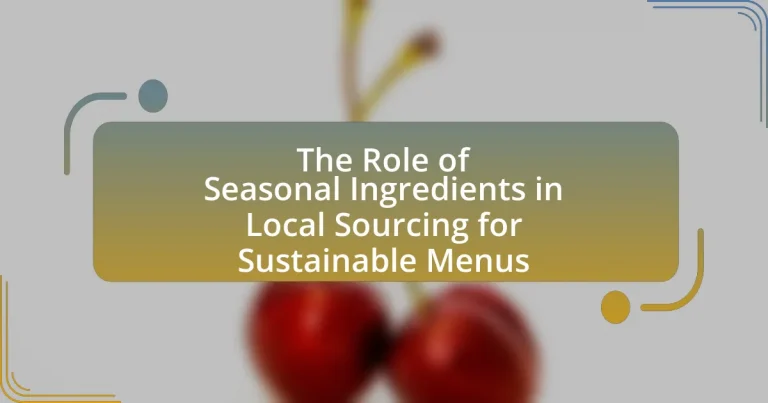The article focuses on the role of seasonal ingredients in local sourcing for sustainable menus, emphasizing their importance in enhancing freshness, reducing carbon footprints, and supporting local economies. It discusses how utilizing seasonal produce maximizes flavor and nutritional value while minimizing transportation emissions, thereby fostering community relationships and economic stability. The article also highlights the environmental benefits of seasonal ingredients, the challenges associated with their use, and strategies for restaurants to effectively implement them in their menus. Additionally, it explores the impact of technology and customer education on promoting seasonal dishes, ultimately advocating for best practices in creating sustainable menus.

What is the role of seasonal ingredients in local sourcing for sustainable menus?
Seasonal ingredients play a crucial role in local sourcing for sustainable menus by enhancing freshness, reducing carbon footprints, and supporting local economies. Utilizing seasonal produce ensures that ingredients are harvested at their peak, which maximizes flavor and nutritional value. This practice minimizes transportation emissions since local sourcing reduces the distance food travels from farm to table. Furthermore, it fosters community relationships and economic stability by supporting local farmers and producers, which is essential for sustainable food systems. Studies indicate that menus featuring seasonal ingredients can significantly lower greenhouse gas emissions associated with food production and distribution, reinforcing the importance of this approach in sustainable culinary practices.
How do seasonal ingredients contribute to sustainability in menus?
Seasonal ingredients contribute to sustainability in menus by reducing the carbon footprint associated with transportation and storage. When restaurants use ingredients that are in season locally, they minimize the need for long-distance shipping, which often involves fossil fuel consumption. For example, a study by the Food and Agriculture Organization (FAO) indicates that food transportation can account for up to 11% of total greenhouse gas emissions in the food supply chain. Additionally, seasonal ingredients are typically fresher and require fewer preservatives, leading to less food waste. This practice supports local economies and encourages biodiversity by promoting the cultivation of a variety of crops.
What are the environmental benefits of using seasonal ingredients?
Using seasonal ingredients significantly reduces the environmental impact of food production. Seasonal ingredients require less energy for transportation and storage, as they are grown locally and harvested at their peak, minimizing the carbon footprint associated with long-distance shipping. Additionally, seasonal farming practices often promote biodiversity and soil health, as they align with natural growing cycles and reduce the need for chemical fertilizers and pesticides. Research indicates that local, seasonal produce can lower greenhouse gas emissions by up to 50% compared to out-of-season imports, highlighting the substantial environmental benefits of choosing seasonal ingredients.
How do seasonal ingredients impact local economies?
Seasonal ingredients positively impact local economies by boosting agricultural sales and supporting local farmers. When consumers prioritize seasonal produce, they contribute to increased demand for locally grown food, which can lead to higher income for farmers and stimulate job creation in the agricultural sector. For instance, a study by the USDA found that local food systems can generate up to $4.8 billion in economic activity annually. Additionally, seasonal ingredients often require less transportation, reducing costs and environmental impact, further benefiting local economies.
Why is local sourcing important for sustainable menus?
Local sourcing is important for sustainable menus because it reduces the carbon footprint associated with food transportation and supports local economies. By sourcing ingredients from nearby farms, restaurants minimize the distance food travels, which significantly lowers greenhouse gas emissions. According to a study by the Food and Agriculture Organization, local food systems can reduce emissions by up to 50% compared to conventional supply chains. Additionally, local sourcing fosters community relationships and encourages the use of seasonal ingredients, which are often fresher and more nutritious. This practice not only enhances the quality of the menu but also promotes biodiversity and sustainable agricultural practices within the region.
What are the advantages of sourcing ingredients locally?
Sourcing ingredients locally offers several advantages, including fresher produce, reduced environmental impact, and support for local economies. Freshness is achieved because local ingredients are harvested at peak ripeness and delivered quickly, enhancing flavor and nutritional value. Additionally, sourcing locally minimizes transportation emissions, contributing to sustainability by reducing the carbon footprint associated with long-distance food transport. Supporting local farmers and businesses strengthens community ties and stimulates the local economy, as money spent on local products tends to circulate within the community. These benefits collectively promote a more sustainable food system.
How does local sourcing reduce carbon footprints?
Local sourcing reduces carbon footprints by minimizing transportation distances for food products. When food is sourced locally, it typically requires less fuel for transportation, which directly decreases greenhouse gas emissions associated with long-distance shipping. For instance, a study by the USDA found that food transported over 1,500 miles generates significantly more carbon emissions compared to food sourced within a 100-mile radius. Additionally, local sourcing often supports sustainable farming practices that further contribute to lower carbon outputs, as these farms may utilize organic methods and reduce reliance on fossil fuels.
What challenges are associated with using seasonal ingredients in local sourcing?
Using seasonal ingredients in local sourcing presents challenges such as limited availability, variability in quality, and higher costs. Limited availability occurs because certain ingredients can only be harvested during specific times of the year, which restricts menu options for restaurants and consumers. Variability in quality arises from factors like weather conditions and local farming practices, leading to inconsistent product standards. Higher costs can result from the need to source ingredients from multiple local suppliers to meet demand, which may not always be economically feasible. These challenges can complicate the implementation of sustainable menus that rely on seasonal ingredients.
How do climate changes affect the availability of seasonal ingredients?
Climate change significantly impacts the availability of seasonal ingredients by altering growing conditions, which affects crop yields and harvest times. For instance, rising temperatures can lead to earlier flowering and fruiting in plants, disrupting traditional growing seasons and potentially resulting in mismatches between supply and demand. A study published in “Nature Climate Change” by Lobell et al. (2011) found that climate change has already reduced yields of staple crops like wheat and maize in some regions, indicating a direct correlation between climate variability and agricultural productivity. Additionally, extreme weather events, such as droughts and floods, can further diminish the availability of seasonal ingredients, making it challenging for local sourcing efforts aimed at creating sustainable menus.
What are the logistical challenges of sourcing seasonal ingredients locally?
Sourcing seasonal ingredients locally presents logistical challenges such as limited availability, transportation issues, and storage constraints. Limited availability arises because seasonal ingredients can only be harvested during specific times of the year, which can lead to supply shortages. Transportation issues include the need for timely delivery to ensure freshness, as local farms may be located far from distribution centers or restaurants. Storage constraints occur due to the perishable nature of many seasonal ingredients, requiring efficient inventory management to minimize waste. These challenges can hinder the ability to consistently provide fresh, local produce, impacting menu planning and sustainability efforts.

How can restaurants effectively implement seasonal ingredients in their menus?
Restaurants can effectively implement seasonal ingredients in their menus by establishing partnerships with local farmers and suppliers to ensure a consistent supply of fresh produce. This approach allows restaurants to create dishes that highlight the flavors and nutritional benefits of ingredients at their peak ripeness, which can enhance customer satisfaction and loyalty. For instance, a study by the Culinary Institute of America found that menus featuring seasonal ingredients can increase customer interest and willingness to pay, as diners often seek unique and fresh dining experiences. Additionally, incorporating seasonal ingredients can reduce food waste and lower transportation costs, contributing to a more sustainable operation.
What strategies can chefs use to incorporate seasonal ingredients?
Chefs can incorporate seasonal ingredients by establishing relationships with local farmers and producers to ensure a fresh supply of seasonal produce. This strategy allows chefs to create menus that reflect the current harvest, enhancing flavor and sustainability. For instance, utilizing farmers’ markets enables chefs to access a variety of seasonal fruits and vegetables, which can lead to innovative dishes that change with the seasons. Additionally, chefs can plan their menus around seasonal availability, using a calendar to track peak seasons for different ingredients. This approach not only supports local agriculture but also reduces the carbon footprint associated with transporting out-of-season produce. By focusing on seasonal ingredients, chefs can enhance the quality of their dishes while promoting sustainability in their culinary practices.
How can menu planning be adapted to seasonal availability?
Menu planning can be adapted to seasonal availability by incorporating ingredients that are at their peak during specific times of the year. This approach not only enhances flavor and freshness but also supports local agriculture and reduces carbon footprints associated with transportation. For example, using tomatoes in summer and root vegetables in winter aligns menu offerings with what is naturally available, ensuring optimal taste and sustainability. Studies show that seasonal eating can lead to a 30% reduction in food miles, thereby promoting environmental sustainability.
What role does customer education play in promoting seasonal dishes?
Customer education plays a crucial role in promoting seasonal dishes by informing consumers about the benefits of eating locally sourced, seasonal ingredients. Educated customers are more likely to appreciate the freshness, flavor, and nutritional value of seasonal dishes, which can lead to increased demand. Research indicates that when consumers understand the environmental and economic advantages of supporting local farmers, such as reduced carbon footprints and bolstered local economies, they are more inclined to choose seasonal options. For instance, a study by the USDA found that consumers who are aware of the benefits of seasonal eating are 30% more likely to purchase seasonal products. This knowledge not only enhances customer satisfaction but also fosters a sustainable food culture.
How can technology assist in sourcing seasonal ingredients locally?
Technology assists in sourcing seasonal ingredients locally by providing platforms that connect consumers directly with local farmers and producers. These platforms, such as farm-to-table apps and online marketplaces, enable users to identify and purchase seasonal produce based on their geographic location. For instance, a study by the USDA found that digital tools can increase local food sales by 30%, demonstrating the effectiveness of technology in enhancing access to fresh, seasonal ingredients. Additionally, data analytics can help farmers predict seasonal trends and optimize crop planning, ensuring that they grow the right products at the right time, further supporting local sourcing efforts.
What tools are available for tracking seasonal produce availability?
Tools available for tracking seasonal produce availability include online databases, mobile applications, and local agricultural extension services. Online databases like Seasonal Food Guide provide comprehensive information on what produce is in season by region, while mobile apps such as Harvest to Table offer real-time updates on seasonal fruits and vegetables. Additionally, local agricultural extension services often publish seasonal calendars that detail the availability of produce based on local growing conditions. These resources help consumers and businesses make informed decisions about sourcing seasonal ingredients, thereby supporting sustainable menus.
How can online platforms facilitate local sourcing for restaurants?
Online platforms can facilitate local sourcing for restaurants by connecting them directly with local farmers and suppliers, streamlining the procurement process. These platforms often feature searchable databases that allow restaurants to find seasonal ingredients based on availability, thereby promoting the use of fresh, local produce. For instance, platforms like Farmigo and LocalHarvest enable restaurants to place orders directly from nearby farms, reducing transportation costs and time. This direct connection not only supports local economies but also enhances the sustainability of restaurant menus by prioritizing seasonal ingredients, which are often more nutritious and flavorful.

What are the best practices for creating sustainable menus with seasonal ingredients?
The best practices for creating sustainable menus with seasonal ingredients include sourcing locally, prioritizing organic produce, and designing menus that reflect seasonal availability. Sourcing locally reduces transportation emissions and supports local economies, while prioritizing organic produce minimizes chemical use and promotes biodiversity. Designing menus that change with the seasons allows chefs to utilize the freshest ingredients, which enhances flavor and reduces waste. Research indicates that local sourcing can decrease carbon footprints by up to 50% compared to ingredients transported over long distances, reinforcing the importance of these practices in sustainability efforts.
How can restaurants measure the sustainability of their menus?
Restaurants can measure the sustainability of their menus by evaluating the sourcing of ingredients, assessing the environmental impact of food production, and analyzing waste management practices. By prioritizing seasonal ingredients sourced from local farms, restaurants can reduce carbon footprints associated with transportation and support local economies. Research indicates that local sourcing can decrease greenhouse gas emissions by up to 50% compared to imported ingredients. Additionally, tracking metrics such as water usage, energy consumption, and food waste can provide concrete data on sustainability efforts. Implementing these measures allows restaurants to create a more sustainable menu while contributing positively to the environment and community.
What metrics should be used to evaluate sustainability in menu planning?
To evaluate sustainability in menu planning, metrics such as carbon footprint, water usage, and local sourcing percentage should be utilized. The carbon footprint metric assesses the total greenhouse gas emissions associated with food production and transportation, providing insight into environmental impact. Water usage metrics quantify the amount of water required for food production, highlighting resource efficiency. Local sourcing percentage measures the proportion of ingredients sourced from local producers, promoting community support and reducing transportation emissions. These metrics collectively offer a comprehensive framework for assessing the sustainability of menu planning.
How can feedback from customers influence sustainable practices?
Customer feedback can significantly influence sustainable practices by providing insights into consumer preferences and expectations regarding environmental responsibility. When customers express their desire for sustainable options, businesses are motivated to adopt practices such as sourcing seasonal ingredients locally, which reduces carbon footprints and supports local economies. For instance, a survey by Nielsen found that 66% of consumers are willing to pay more for sustainable brands, indicating that customer demand can drive companies to prioritize sustainability in their sourcing strategies. This alignment between consumer feedback and business practices fosters a cycle where companies continuously adapt to meet sustainability expectations, ultimately leading to more environmentally friendly operations.
What tips can chefs follow to maximize the use of seasonal ingredients?
Chefs can maximize the use of seasonal ingredients by sourcing them from local farmers and markets, ensuring freshness and supporting the local economy. Utilizing seasonal produce not only enhances flavor but also reduces transportation costs and environmental impact. For instance, a study by the USDA indicates that locally sourced ingredients can decrease carbon emissions associated with food transport by up to 30%. Additionally, chefs should plan menus around the seasonal availability of ingredients, allowing for creative dishes that highlight peak flavors. Engaging in community-supported agriculture (CSA) programs can also provide chefs with a consistent supply of seasonal produce, fostering a direct relationship with local growers.
How can chefs creatively use seasonal ingredients to enhance flavor profiles?
Chefs can creatively use seasonal ingredients to enhance flavor profiles by incorporating fresh, locally sourced produce that reflects the peak flavors of each season. For example, using ripe summer tomatoes in a salad can provide a burst of sweetness and acidity, while winter root vegetables can add earthiness and depth to a dish. Seasonal ingredients often have higher nutrient content and better flavor due to being harvested at their peak, which can significantly elevate the overall taste experience. Studies show that dishes made with seasonal ingredients can lead to increased customer satisfaction and loyalty, as diners appreciate the freshness and quality associated with local sourcing.
What are some common pitfalls to avoid when sourcing seasonal ingredients?
Common pitfalls to avoid when sourcing seasonal ingredients include failing to research local availability, which can lead to purchasing out-of-season products that compromise sustainability. Additionally, neglecting to establish relationships with local farmers can result in inconsistent quality and supply issues. Not considering the environmental impact of transportation can also undermine the benefits of sourcing locally. Lastly, overlooking the importance of proper storage and handling can lead to spoilage, negating the advantages of using fresh, seasonal produce.


